Note from the author:
On request a more extensive and complete elaboration is available as a *.pdf file.
Contact for a free copy either the publisher or [email protected]
Introduction
Speculations that Homo Sapiens was created by genetic engineering are a recurring hypothesis in alternative prehistory. Although worldwide and consistent creation myths suggest the permissibility of this creation thesis, the arguments presented so far are not so convincing that they would have found their way into the official doctrine of historical science. On the contrary, instead of an unbiased examination, this alternative to evolution is discredited as a conspiracy theory or is made ridiculous by pointing out errors in layman discussions. In fact, too often, the advocates of this thesis lack the necessary expertise. Thus, their arguments remain superficial.
The discussions regarding the creation of homo sapiens by genetic engineering refer primarily to reports from the prehistoric and early cultures of Mesopotamia with the Old Testament as the most widespread collection of legends.1
This creation thesis is supported and supplemented by ancient Egyptian traditions, which have preserved a wealth of information covering a period of more than 3000 years. As valuable as the news from these two cultures may be, we find compelling evidence in a completely different place and in a completely different historical context, namely in Central America.
Basic Biochemistry
In recent decades, science has made rapid progress in clarifying how life functions. Hardly fifty years have passed since DNA 2 was recognized as the carrier of the code of life, and its molecular structure was elucidated. Life has been traced back to the arrangement and interaction of a few basic building blocks, one of which (nucleotides) serves as an information store and the other (amino acids) as a building material.
The genes store the program according to which the living organism forms and functions. However, at the beginning of the creation of life, this program didn’t exist, but everything started with the building material, the amino acids, which represent the building blocks of life but do not create life on their own. Only the later added program using the DNA as a storage medium created complex living beings. The program stored in the genes controls the combination of amino acid molecules to proteins bringing order and sequence into the chaos of chemical reactions by assigning function and task to the proteins, e.g. in the form of tissue and enzymes. Comparable to a plan which erects a house out of a pile of stones, DNA combines and organizes amino acids into oligo- and polymeric chains, which become organs and, in the end, a functioning living being.
Even the length of one DNA strand, which in case of humans, measures about two meters when unwound, leaves one speechless. In fact, every single one of the 100 trillion (1014) cells of a human body carries the complete strand within itself. Unlike DNA, proteins form only short molecular chains, in which only up to a several thousand amino acid units are linked together. Thus, compared to the DNA, strand proteins are very, very short!
Even when higher life forms are left disregarded, self-replication of complex molecules is the prerequisite for any life. Without order and permanent regulation of function, self-replication alone leads at best to a molecule cluster. DNA alone gives shape and function to a giant molecule, on the next hierarchical level of a cell and then to the cell cluster. To push the complication to the extreme, only a specific part of the DNA becomes active in each organ. Since in a cell the overwhelming portion of the genome is muted, only a tiny part of the DNA strand creates the organ. Within each cell of a given organ, specific macromolecules initiate the appropriate chemical reactions – and only those – by expressing a particular cell-specific DNA snippet for protein synthesis. The structure of these macromolecules, the cell-specific unwinding and activation of the proper DNA segments and their interaction with enzymes is no less complex than the DNA itself. During growth, as well as in the adult state, the DNA controls the synthesis of macromolecules, allows organs to grow and switches specific regulators and enzymes for the interaction of cells on and off again. Ever since this program, inherited from parents to their children, sorts the chaotic molecule heap and combines amino acids specifically into to proteins by use of genetically stored information bytes – codons in the language of biochemistry – living beings exist.
Life uses twenty (so-called essential) amino acids as building blocks of proteins. These amino acids combine function-specific into a protein in a sequence and length which is determined by a cell-specifically expressed DNA-segment. The morphology of a creature and the functioning of its organs is based on the combination of these twenty basic molecules to form chains. As simple as the chemical structure of an amino acid molecule is, complexity prevails in the morphological structure of the protein, in the surrounding chemistry of enzymes (macromolecular, protein-based catalysts) and vitamins. This interaction ensures the smooth functioning of a living being.
The common origin of all earthly life proves neither a – silently assumed – linearity of evolution with man as the goal and crown of creation, nor that man is entirely a product of evolution. The still admissible question about the appearance of man as a creature now, however, presents itself more restrictive: Is man the unadulterated product of evolution, or has there been an artificial intervention in the genome of his ancestors?
In fact, only a small part of the genome is expressed for protein synthesis. The size of the dispensable or the (at least for protein synthesis) unexploited storage capacity of a DNA strand makes it clear that only fractions of the genome need to be altered to create an artificial being. This is valid at least as long as the artificial creature remains closely related to an already existing living being. The relationship of human DNA to that of a chimpanzee (until recently the match was assumed to be 98.5%) 3 suggests which species might have served as a supplier of genes for a homunculus. One evolutionary step closer, the Neanderthal was a more closely related species of modern humans than monkeys are.
In any case, an inheritable genetic manipulation would be conspicuous as a leap in the genome development of a living being. Still, retrospectively it would be difficult to distinguish it from an evolutionary mutation.
Approach and historical documents
To question evolution in favour of genesis is only allowed and serious when clear evidence is presented instead of expressing hints and doubts. Based on the strong hypothesis of the creation of man, we will interpret historical documents and, step by step, substantiate the hypothesis to obtain admissibility of the alternative explanation. Thus, in line with Popper’s epistemological demand, 4 we start with a falsifiable and therefore admissible hypothesis.
We will outline that documented writings go far beyond the fairy-tale character of creation myths, containing knowledge which makes prehistoric biochemistry and, in this context, the creation of man probable.
In the documents that we will use for the proof, ancient knowledge is handed down to us. Because of the age of this report which dates back millennia, we do not hold originals in hand but rather copies. From an ancient past where the Creator of homo sapiens created first men, written testimonies are preserved, at least in terms of content. There is no trace of the knowledge bearers themselves. Fortunately for us and suitable to the importance of the subject, copying continued although the knowledge had faded away and the knowledge bearers had withdrawn or perished. At some point in time, the copyists no longer understood what they were copying, but the tradition of a tabooed cult acted as a preserver. The copyists did not change the content of the information; however, they modified drawings according to their cultural background and understanding. Abstract formulas and complicated machines were stylized or alienated depicting now snakes, birds, or other animals. The challenge of an interpretation is to deduct the original meaning, machine, or formula from these alienated representations.
The technical message is not directly striking because already the lost, original drawings will trivially have used a different formula language than today’s science. Formal differences in the representation are therefore inevitable, but we must not allow any deviation or concessions in the content of the message. Obviously, a lost prehistoric chemistry cannot differ from today’s chemistry, since molecules and reactions are the same by nature. Despite all alienation, the scientific content of the handed-down documents either reveals itself beyond doubt, or it does not exist.
In fact, and probably motivated by the Bible’s model character, the current discussion on the creation of man is primarily based on traditions from the Near East. As already said, these reports may well have a value, but, as their disregard by established science shows, they are too poor in facts to be convincing. The images and myths originating from the Near East – including the Genesis of the Old Testament – could be religiously motivated fairy tales without any real background.
Hypothesis
We discover the arguments for the creation of man by genetic manipulation in picture stories (codices) which the Spanish conquistadors came across in Central America. Although lamentably, only a few works of the Central American high civilizations have survived, the pages of these codices reveal a forgotten world of knowledge. Looking at them with some background knowledge, they contain information in genetic engineering, biochemistry and biology on the highest level.
While the significance of some ancient American codices for calendar science has been well researched and understood, other codices are labelled as “cult representations”. Although the word cult is correct, it remains virtually sterile as long as no more explanation than a description of the image can be attributed to the cult. Instead of the meaningless explanation of ‘being cult’ or ‘being a depiction of a cult,’ we will assign to these alleged cults and rituals a factual origin and background. After that, the drawings represent still cult but of a completely different kind, namely no longer a void statement, but a heritage that we understand in its meaning.
The main work in the collection of codices is the Codex Borgia. The current understanding of its content basically maintains the first interpretation done by Eduard Seler in his more than 100 years old and 1000-page standard work. 5 In large parts still cryptic, 18 pages are said to deal with astronomy and seasonal weather variations. 20 repeatedly shown glyphs are the basis of the interpretation and are used to justify the classification of the Codex Borgia as a calendar compendium. As already stated by Seler the Codex Borgia, the Codex Cospiano, the Codex Vaticanus B, Codex Lauda and the Codex Fejervary-Mayer combine to a group of similar content.
The origin of the codex is assumed to be in the period before the Spanish conquest in the area of the present city of Puebla, southeast of Mexico City. The Codex Borgia is named after Cardinal Stefano Borgia (1731 to 1804), scholar, historian, and collector. The codex was already in possession of the Vatican in the 16th century, as a handwritten note on page 68 proves. Today the codex is kept in Rome in the Biblioteca Apostolica Vaticana. 6 Given its age, the state of preservation of the codex is good. Only the first pages are faded, and illegible. Otherwise, traces of ageing, which impair the images, are usually limited to the edges of the individual pages.
The salvation of these codices calls for gratitude since missionaries and the church have done their best to eradicate without tolerance any pagan idols and any understanding of the world that competes with or is incompatible with Christianity. Has the Codex Borgia escaped its destruction because it represents a work of such impressive artistry that even zealous missionaries shrank from its destruction? But perhaps this and the few other preserved codices survived only by chance or because of the sloppiness of the holy servants. As much as we lament the rage of the conquerors and missionaries, they are not the only culprits in the loss of ancient documents. Nature, too, contributes to decay and oblivion. Left in the same place and without being preserved in a museum, the codices would have rotted by now. Their transfer to Europe has – unintentionally – made a decisive contribution to their preservation. Incidentally, the decay of the codices due to ageing explains trivially why we cannot find any originals but must consider ourselves lucky to hold copies in hand.
The Classical Understanding of the Codices
The pictures in the codex are interpreted in large parts as calendar information with special consideration of the phases of the moon and Venus. Eduard Seler and subsequent analysts break up the drawing on any page into fragments, each of which they discuss wordily but without reference to a superordinate storyline. Contrary to the claim, the interpretations of the pictures remain descriptive and – contrary to the logic of a book – widely unrelated. Usually, the interpretations are limited to the naming of the depicted gods. Rarely they are associated with myths and glyphs from other ancient sites. Assuming the glyphs to be signs of the calendar, Seler toils himself rambling exhaustingly through the heaven of gods in ancient Mexico. Since the day signs of the Borgia Codices differ from the day signs of the Codex Dresdensis 7, Seler argues with all kinds of parallelisms without giving a reason for the substitution of the signs or proof of the permissibility of the substitutions. When it goes beyond the description of the obvious, Seler refers and explains by referring to the Codex Dresdensis. After adopting the leitmotif of calendar interpretation, this assumption has clearly led his thinking. His subjunctive formulations are eloquent references to the uncertainty of his analysis. Over 800 pages, insufficient understanding is wordily hidden. The hasty introduction of a further god – the range extends from the god of wind and moon to the god of corn and bats – in the absence of classification in an overall context has a confusing rather than an explanatory effect.
Strangely enough, the fact that numbers are missing in the codices of the Borgia series is not addressed. Von Däniken questions the interpretation of the Codex Borgia as a book of the Mayan calendar. 8 To him the codex doesn’t refer to a calendar but covers the alienated representation of lost biotechnology. However, Däniken’s explanations remain brief and technically superficial.
An Alternative Interpretation of the Codices
Basically, we follow Däniken’s opinion and argue that the drawings of complex apparatuses and processes in the codices represent advanced biochemistry. According to our assessment, the recurring glyphs do not represent the 20 days of the Tzolkin calendar, but the 20 essential amino acids. Going beyond, the codices preserve genetic engineering in a quantitative form which suffices to bring assumptions to the level of evidence.
The artistically outstanding Codex Borgia is the most comprehensive and at the same time the most precise in its explanations of genetic engineering. Once the thread of a genetic engineering interpretation is taken up, the content of the codex becomes coherent and comprehensible without any contradiction.
A simplifying drawing, page 20 of the Codex Borgia (see picture A) summarizes the act of creation in allegorical depiction. On this page of the Codex, we find – reduced to the essential – the essential steps of the process of creation.
The drawing shows an overview of the process. A god cuts DNA, depicted as a double-stranded snake with a split head and tail. A new genome is re-arranged from snake (DNA) segments in a synthesis bath. The newly created genome grows out of the bath as a double-stranded strain. On the chemical reactor, the result of the creation is symbolically represented by a child crawling out of a jug. To us, the jug represents an incubator or artificial womb, in which the newly created being grew up.
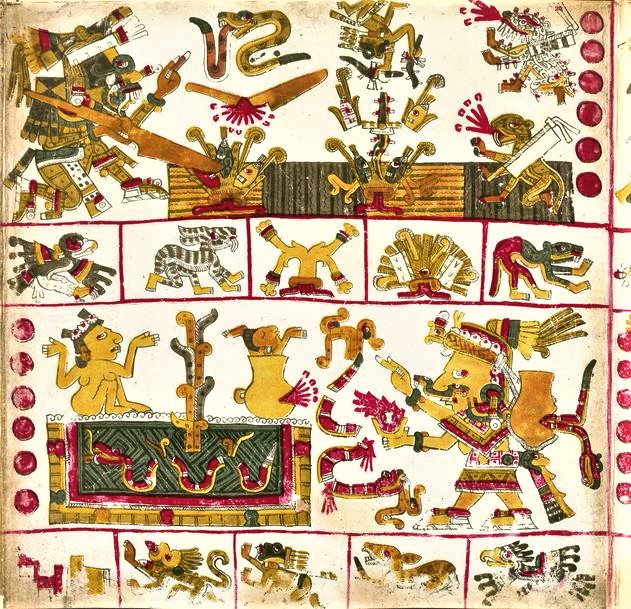
Picture A
Page 20 of the Codex Borgia 9
Upper part: Preparation of a chemical synthesis bath
Lower part: Technical principles and procedure of genetic creation
(PD0)
Once the door to the scientific explanation has been opened, other pictures reveal genetic engineering, biochemistry and biology straightforwardly. Although depictions look alienated compared to modern representations, they preserve the essential information. A naturalistic alienation and arabesque decoration should be owed to the fact that during centuries non-specialists repeatedly copied lost originals. In any case, drawings which so far are interpreted as representations of calendar science are reinterpreted in a trivial and consistent manner.
The currently taught calendar interpretation stems from numerological conspicuousness. Since the Mayan calendar is based on the number 20, the constant occurrence of these 20 glyphs shown on the pages led to this interpretation. However, what we encounter here is a premature explanatory approach since the occurrence of 20 glyphs also fits perfectly into the genetic engineering interpretation. After all, all proteins are composed of 20 different, so-called essential amino acids. In addition to these 20, there are 3 non-essential amino acids, which can be incorporated in a protein alternatively for an essential amino acid. In fact, in Codex Borgia we count 23 different glyphs, although only 20 are shown per page. Strangely enough, the 3 surplus glyphs are either missed or ignored in the calendar thesis.
The fact that there are always 20 glyphs per page in framing bands and as pictorial decorations, but 23 different glyphs are listed in overview tables, speaks for the conclusiveness of the genetic engineering interpretation. This approach also explains the appearance of characteristic signs always in the number of 4. This repeating occurrence of 4 differently coloured signs we assign to the 4 nucleotides which build the code of the DNA.
Codices: Books of life and technology
As an example, for a biochemical process description, see Picture B, which shows a naturalistically alienated representation of genetic manipulation. The snake in the main image represents a DNA strand metaphor while the modification of RNA (RNA: Single strand read out DNA) is captured in the secondary image at the left margin.
While Pictures A and B might represent a daring interpretation of other representation of biochemical processes, as they are illustrated in today’s drawings of modern genetics compare perfectly with illustrations in the codices. They elucidate the underlying processes to a matching detail.
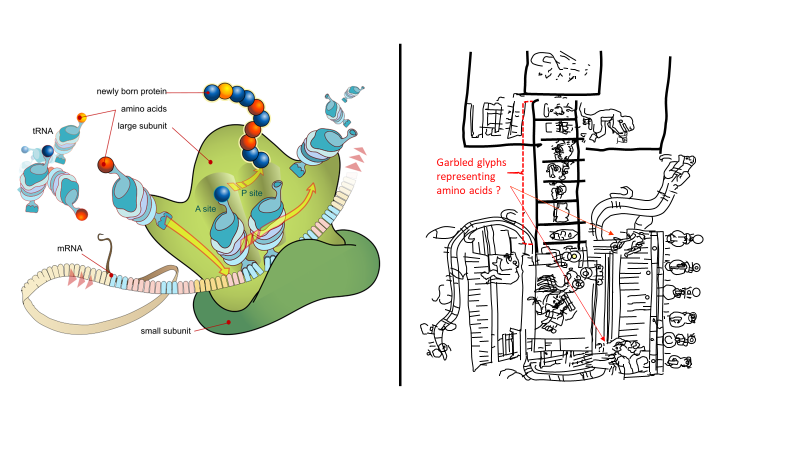
Picture C
Comparison of a process representation in a codex with a modern representation of protein synthesis.
Left: Modern graphic of protein synthesis 11, (PD0)
Right: Contour sketch of a cutout of page 16 of the Codex Vaticanus 3773B. 12 The glyphs in the ladder represent amino acid molecules; the snake stands for the RNA.
Page 16 of Codex Vaticanus 3773B (Picture C) constitutes a cornerstone in the reinterpretation of the codices. In it, we do not interpret numbers or symbols but encounter a perfectly reproduced process. In such remarkable agreement, we come across a technical explanation for further pictures as well. Modern biology of heredity rejects the apodictic Darwinian doctrine of the immutability of DNA in a living being. In addition to the statistically occurring germline mutations (classical evolutionary theory), it grants the environmentally driven modification of DNA an active and above all accelerating role in environmental adaptation, i.e. evolution. DNA is much less frozen in than previously assumed. It changes according to life circumstances and environmental influences. What nature does, man can do nowadays as well. A breakthrough in DNA modification using targeted integration of gene sequences is marked by the so-called CRISPR /Cas9 technique, which became known in public by the keyword ‘programmable genetic scissors’. With this technique, a gene segment can be altered with pinpoint accuracy without affecting the rest of the genome. The door to biotechnology that changes living organisms and which is indistinguishable from natural mutation processes is open – at least it has been opened wide. In analogue similarity to the schematic description of protein synthesis on page 16 of Codex Vaticanus 3773B, we find a drawing in Codex Borgia that shows an alienated but still recognizable representation of the CRISPR/Cas9 technique (Picture D).
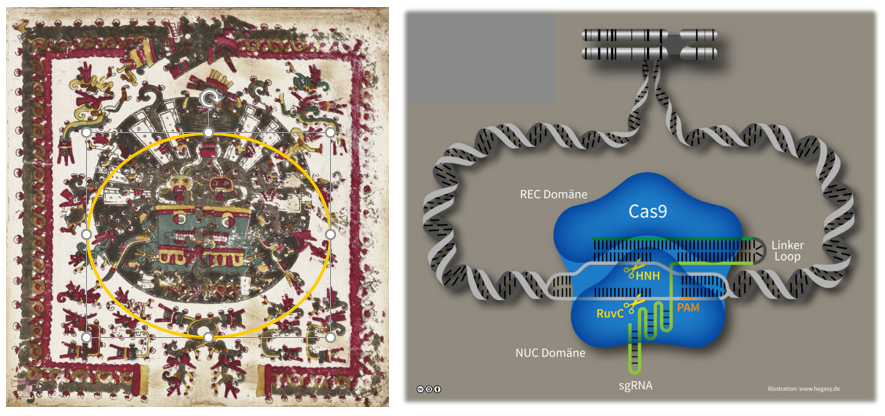
Picture D
Comparison of an image from the Codex Borgia with a model drawing of gene editing by use of CRISPR/Cas9
Left: Page 29 of the Codex Borgia 13 (PD0)
Right: Modern illustration of CRISPR-Cas9 14 by Guido4, (CCBYSA4.0)
Encircled shown is the section of the Codex image, which shows the remarkable correspondence with the modern representation.
Besides Crossing 15 (section of page 95 of the Codex Vaticanus 3773B) and CRISPR-Cas9, we detect TALEN (Transcription activator-like effector nuclease) 16 from other drawings as other genetic engineering techniques (left margin of page 34 of the Codex Borgia). The TALEN technique is used to lead an altered gene sequence back to the original DNA. In medicine, it is now used for cancer therapy.
Machines and apparatuses
On page 49 and page 51 of the Codex (see Picture E) one machine each is shown, which is reminiscent of a wringer or an enclosed automatic drill stand. The central component of the construction is a wheel with 8 pins, which is roofed by a multi-stage construction. Fine scales above and below the central unit indicate the complexity and technical perfection. There is no doubt that such an elaborate machine, whose complexity and precision the drawing elements emphasize, cannot be made of wood or stone. Instead, the line scales at the table of the machine fit a micrometre screw, but certainly not to a device built in a Stone or Bronze Age society, in which the Indians of Mexico lived at the time of the conquistadors. This multi-layered drawing fits fully and seamlessly into the biochemical context.
It should be noted that page 51 of the Codex Borgia is only a picked example; other pictures of the codices, such as page 49 or 68 of the Codex Borgia, show similar devices.
If we classified Picture C as drawing of protein synthesis, the chemistry of Picture E (a) starts one level of synthesis earlier. It is not shown how amino acid molecules are polymerized into proteins, but how DNA is synthesized. The machine builds the strand of DNA on a ribose substrate nucleotide by nucleotide. For illustration purposes, the molecular process is enlarged graphically to a giant model. Different to the graphic model of the molecular synthesis zoomed far beyond scale, the wheel machine is actually macroscopic. Starting from biochemistry as a guiding principle for interpretation, the technician suspects a sample changer in the apparatus or even recognizes an automatic synthesis machine. Picture E (b) shows for explanation and comparison the modern understanding and the technical setup of a machine used to synthesize DNA. Even though it looks more complex and sophisticated, it needs little imagination to recognize the relations to the machine as the codices show it.
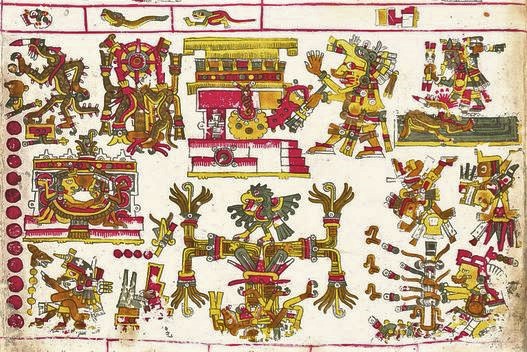
Picture E (a)
Most of page 51 of the Codex Borgia 17 (PD0)
Representation of an automat and process of DNA synthesis from nucleotides with the 4 paired bases ([A, T], [G, C]). The nucleotides are represented by the four-coloured spheres, see also the corresponding cups.
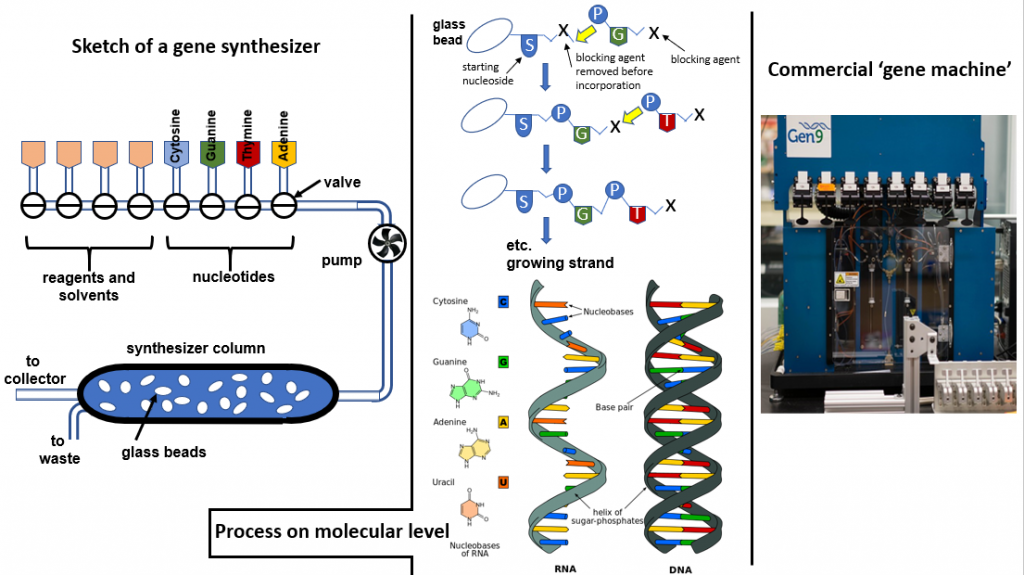
Picture E (b)
Principle and process description of DNA synthesis and modern equipment employed.
Left: Simplified description of how DNA synthesis works technically. 18
Middle: Reaction scheme of the chemical process by which an RNA strand is produced, which is then completed to form the DNA helix. 19 (CCBYSA3.0)
Right: State of the art equipment used to run the process, as shown in the drawing in the middle. 20 by Joi, (CCBY2.0)
In the framing decoration of the Codex drawing the glyphs of the amino acids as well as the symbolism of the DNA-typical double strands (split branches) are shown. The wheel-machine must have been of eminent importance, likely, the central technical device. In amazingly little variation drawings of this automat and its main component, the wheel, are a recurring motif on many pages. For example, the entire machine is depicted on page 18 of the Codex Borgia, on other pages such as on page 44 only the central unit, the wheel, is reproduced. Always the graphics emphasize how the wheel creates a twisted strand out of four basic components – balls in the colours brown, red, green and yellow.
In some pictures, the wheel hovers like a sun over the main drawing, for example on page 57 of the Codex Borgia or pages 18 and 22 of the Codex Zouche-Nuttall 21. Similar to the Codex Borgia in the Codex Vaticanus, entire picture cycles deal with this machine. The fact that the same forgotten biochemistry was recorded in several codices is of little surprise, given the importance we assign to the message contained. Given the common content and background, it becomes almost trivial that, apart from the Codex Borgia, we repeatedly come across the same symbols. In flasks DNA (double strands) is denatured, visualized by snakes splitting in their head and tail. Twisted strands describe DNA, gene sequences are prepared for incorporation into the DNA strand by specific end groups and then linked to form a strand, or they are inserted into a DNA strand. These methods, which use cutting and ligase techniques (linking) to modify DNA, are part of the established toolbox of today’s biochemistry.
Cell Biology
Because of the importance of cells as central structural and functional units in a living being, we expect a chapter on cells and cell structure in every book of life. Cells are the factories of metabolism and at the same time, the smallest living unit, which in the form of the amoeba already lives autonomously. In animals and plants, we find huge cell clusters united to form a complex living being. The body of a human consists of approximately 1014 (= 100 trillion) cells, which interact in a highly specialized way. Regarding size, the cells of an animal or plant represent the mesoscopic link between the living being and the molecules. Their major structures are already visible in a light microscope. Page 30 of the Codex Borgia (see Picture F (a)) fulfils our expectation. Shown is a spherical structure enclosed by a membrane. When we identify this drawing with a cell, the picture represents the link between a molecule and a large organism.
Thus, this page provides the link between the molecular dimension to the microscopic biological scale, leading us from biochemistry to biology. In the drawing, we find the structure of a cell correctly described if we look at the core elements. The rods which protrude from the membrane imitate the surface-active lipids. Given this identification, the structural feature of a cell boundary is perfectly met. Despite the arabesque design, the drawing resembles the cell interior in a remarkably differentiated way. In front of a red background (cytoplasm) the interior is filled with symbols which previously we have assigned to DNA and nucleotides. Picture F (b) illustrates how the modern representation of a cell in the Codex Borgia was alienated. Especially the cell nucleus and the cell wall can easily be assigned to the Codex representation. Especially the layered cell wall is well depicted.
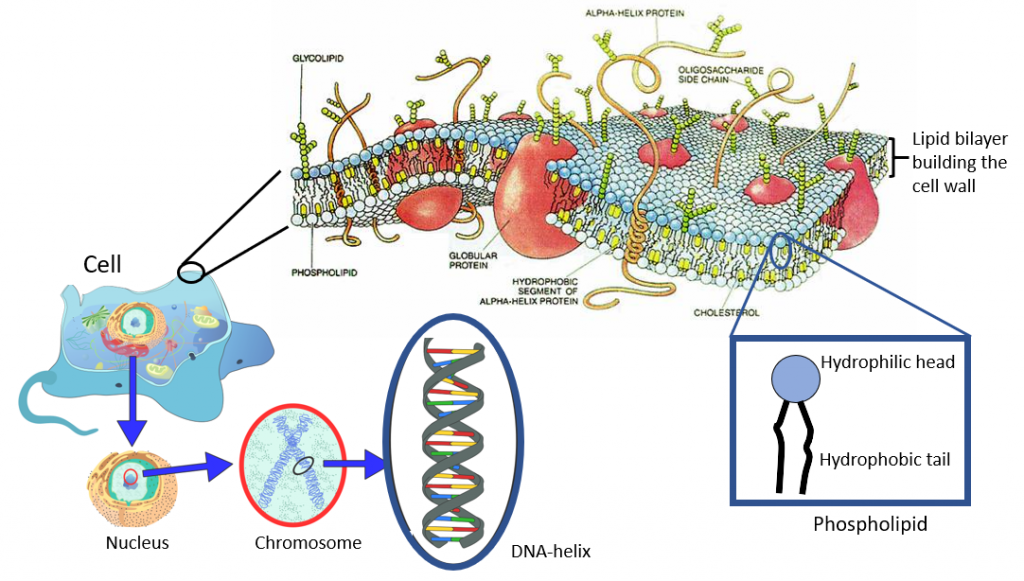
Picture F (b)
Bottom left: Cell structure and main constituents in increasing magnification 23 (PD0)
Top right: Structure of the cell membrane,24 characterized by the structure of an amphiphilic molecule that makes up the cell wall. Image: NIST (CCBY)
In the corners of picture F for decoration, four gods are shown. The reference to biochemistry is straightforward: Each of them carries a DNA tree on its back, symbolized by the split trunk. The branches bear balls, which we classify as the codon of the DNA.
Conclusion
To earlier arguments of alternative prehistorians, which pointed to the creation of man and which were mostly based on myths, we added quantitative and hard to discard evidence. The proposed interpretation of the ancient Mexican codices is convincing in such a way that it does not list interpretable pieces of information but offers a comprehensive explanation for a report handed down in writing. The analysis of the images is coherent in the global description of the codex contents as well as in the explanation of individual images. The correspondence to genetic engineering and biochemistry exceeds the extent which allows coincidence. We could add more than a piece of the puzzle to the theory of the creation of man; we could add a cornerstone to it. In light of our interpretation, messages from other cultures gain weight and truth. Doubts are still allowed, but our interpretation of the Old Mexican codices establishes evidence regarding the creation of man that can hardly be ignored or denied.
Literature
Hancock, Graham (1995), Fingerprints of the Gods: The Evidence of Earth’s Lost Civilization. Three Rivers Press, New York
Däniken, Erich von (1984), Der Tag an dem die Götter kamen. Bertelsmann-Verlag, Munich
Díaz, Gisele Rodgers, Alan (2013), The Codex Borgia: A Full-Color Restoration of the Ancient Mexican Manuscript. Dover Publications, Mineola NCY
Eiling, Aloys (2020), Vergessene Zeiten, Vergangene Welten. Hibarios, Kaarst
Lewin, Benjamin (1993), Genes V. Oxford Uni. Press, Oxford
1References:
Michael Tellinger, “Slave Species of the Gods: The Secret History of the Anunnaki and Their Mission on Earth”, (Bear & Company, Rochester 2012)
Zecharia Sitchin, “When Time Began“, (HarperCollins, New York 1993)
2 DNA: DeoxyriboNucleicAcid
3 http://www.nature.com/nature/journal/v429/n6990/full/nature02564.html
4 Karl Popper, Logik der Forschung, Springer-Verlag, Wien (1935). Available on the Internet at: https://monoskop.org/images/e/ec/Popper_Karl_Logik_der_Forschung.pdf
5 Seler, Eduard (1894), “Codex Borgia – Eine altamerikanische Bilderschrift der Bibliothek der Congregatio de Propanda Fide”, (Berlin 1894). Available on the Internet at: http://www.famsi.org/spanish/research/loubat/Booklets/Seler_Borgia_x.pdf, with x = 1, 2, 3
6 https://digi.vatlib.it/view/MSS_Borg.mess.1
7 http://www.slub-dresden.de/sammlungen/handschriften/maya-handschrift-codex-dresdensis
8 Erich von Daeniken has pointed out this possibility of interpretation, “Der Tag, an dem die Götter kamen“, p. 211-216, (Bertelsmann 1984, Munich)
9 https://commons.wikimedia.org/wiki/File:Codex_Borgia_page_20.jpg
10 https://commons.wikimedia.org/wiki/File:Codex_Borgia_page_33.jpg
11 https://commons.wikimedia.org/wiki/File:Ribosome_mRNA_translation_de.svg
12 Sketch according to reference: http://www.famsi.org/research/loubat/Vaticanus%203773/page_16.jpg
13 https://commons.wikimedia.org/wiki/File:Codex_Borgia_page_29.jpg
14 https://commons.wikimedia.org/wiki/File:15_Hegasy_Cas9_DNA_Tool_Wiki_D_CCBYSA.png
15 https://www.spektrum.de/lexikon/biologie/crossing-over/15784
16 Cermak, Thomas, et al. (2011). Efficient design and assembly of custom TALEN and other TAL effector-based constructs for DNA targeting, Nucleic Acids Research. https://www.ncbi.nlm.nih.gov/pmc/articles/PMC3130291/
17 https://commons.wikimedia.org/wiki/File:Codex_Borgia_page_51.jpg
18 https://biocyclopedia.com/index/genetics/genetic_engineering_and_biotechnology_isolation_sequencing_and_synthesis_of_genes/gene_synthesis_machines.php
19 https://commons.wikimedia.org/wiki/File:Difference_DNA_RNA-EN.svg
20 By Joi – https://www.flickr.com/photos/35034362831@N01/12513436084/, CC BY 2.0, https://commons.wikimedia.org/w/index.php?curid=33255789
21 http://www.famsi.org/research/graz/zouche_nuttall/img_page18.html
22 https://commons.wikimedia.org/wiki/File:Codex_Borgia_page_30.jpg
23https://commons.wikimedia.org/wiki/File:Animal_cell_structure_en.svg
24 https://commons.wikimedia.org/wiki/File:CellMembraneDrawing.jpg






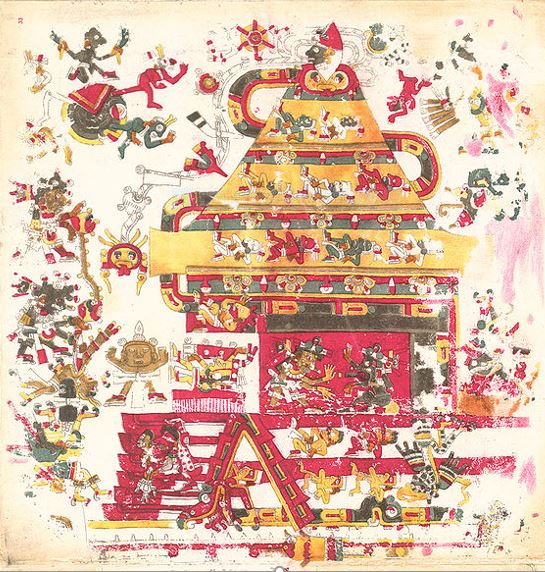
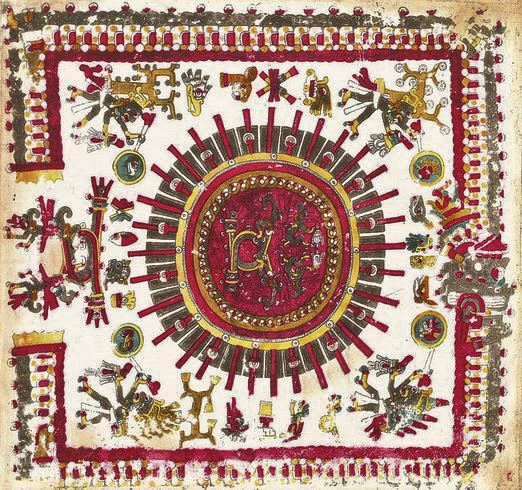
Von Daeniken and Zacheria Sitchin works have all been debunked.
Great speculation but no cigar.
Different to these two guys I run a somewhat more sophisticated approach. May be, my knowledge in biochemistry is of some help for this more profound discussion. At least, the comparison of codex pictures with modern biochemistry goes beyound mere speculation. I think that I could put forward an one to one comparisons of antique and modern graphics which awaits better explanation than mine.
I am impressed with the originality of your work. I have always felt that the calendar interpretation of the Mayan glyphs is suspect. I was never convinced by the standard interpretations. If you are correct, the destruction of most of the Mayan writings by the Spanish conquistadors and Christian missionaries was an incalculable loss, equivalent to losing the great library of Alexandria.
You are using the word “alienated” in a special technical sense. Perhaps you could explain your meaning in more detail.
FYI, the ancestors of the Mayans long predate the Aztecs and Toltecs. The alignment of Mayan sites like Chichen Itza to the former Norway Sea north pole position means the Mayan culture dates to roughly 70-80,000 years BP, based on isotopically dated fossils from the bone caves of Britain that also correlate with the European Ice Age. I discuss this new framework in my just released book Deep History and the Ages of Man. So, please check back, next month. I am scheduled to be author of the month in December 2020!
Regarding the term ‘alienated’ it looks like that I failed in the translation of the German word ‘verfremden’. The German word means something like consciously changing a story or an image, but without changing the message. In most cases the change is done, to make the content more mysterious or exciting. I tried to express that the abstract drawings of molecules has been changed into the drawing of an animal or into an alike looking object.
As far as history of mankind is concerned, I share your opinion that the appearance of man on earth dates back much longer than is officially taught. Meanwhile, official paleontology proofed a first presence of man to the latest at 250,000 BC.